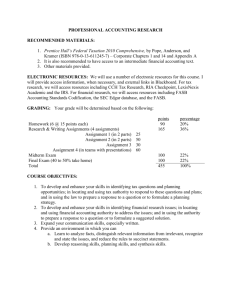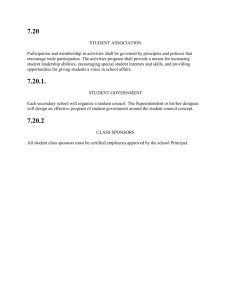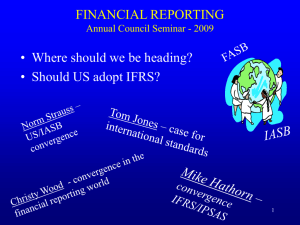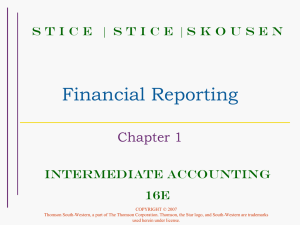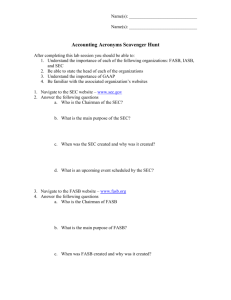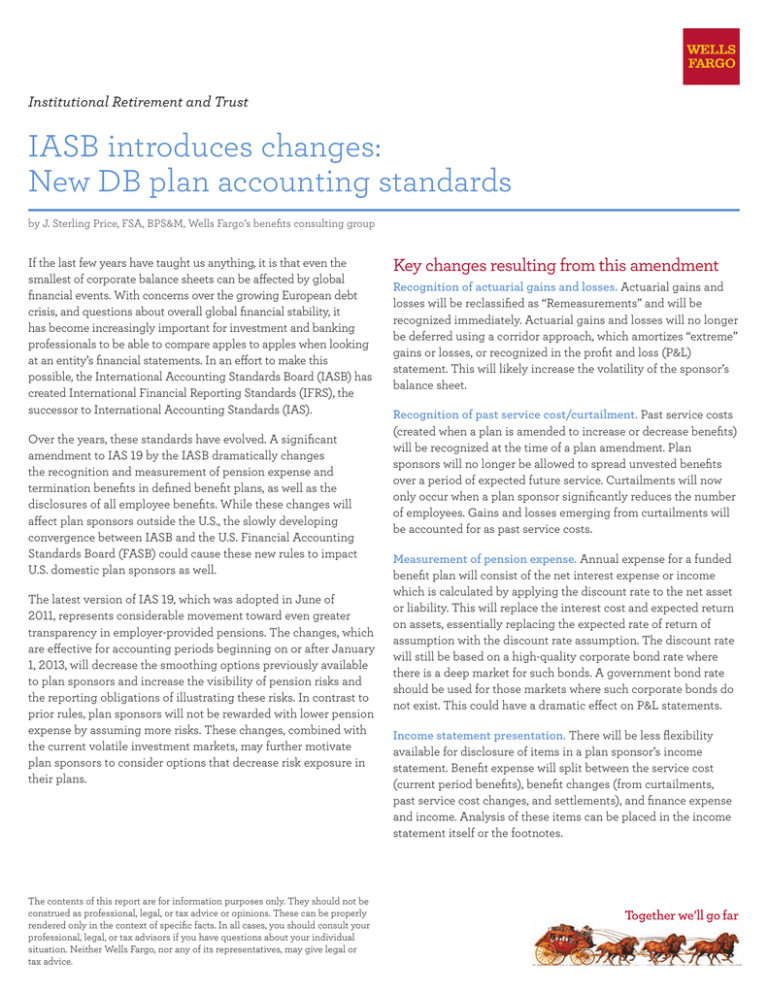
Institutional Retirement and Trust
IASB introduces changes:
New DB plan accounting standards
by J. Sterling Price, FSA, BPS&M, Wells Fargo’s benefits consulting group
If the last few years have taught us anything, it is that even the
smallest of corporate balance sheets can be affected by global
financial events. With concerns over the growing European debt
crisis, and questions about overall global financial stability, it
has become increasingly important for investment and banking
professionals to be able to compare apples to apples when looking
at an entity’s financial statements. In an effort to make this
possible, the International Accounting Standards Board (IASB) has
created International Financial Reporting Standards (IFRS), the
successor to International Accounting Standards (IAS).
Over the years, these standards have evolved. A significant
amendment to IAS 19 by the IASB dramatically changes
the recognition and measurement of pension expense and
termination benefits in defined benefit plans, as well as the
disclosures of all employee benefits. While these changes will
affect plan sponsors outside the U.S., the slowly developing
convergence between IASB and the U.S. Financial Accounting
Standards Board (FASB) could cause these new rules to impact
U.S. domestic plan sponsors as well.
The latest version of IAS 19, which was adopted in June of
2011, represents considerable movement toward even greater
transparency in employer-provided pensions. The changes, which
are effective for accounting periods beginning on or after January
1, 2013, will decrease the smoothing options previously available
to plan sponsors and increase the visibility of pension risks and
the reporting obligations of illustrating these risks. In contrast to
prior rules, plan sponsors will not be rewarded with lower pension
expense by assuming more risks. These changes, combined with
the current volatile investment markets, may further motivate
plan sponsors to consider options that decrease risk exposure in
their plans.
The contents of this report are for information purposes only. They should not be
construed as professional, legal, or tax advice or opinions. These can be properly
rendered only in the context of specific facts. In all cases, you should consult your
professional, legal, or tax advisors if you have questions about your individual
situation. Neither Wells Fargo, nor any of its representatives, may give legal or
tax advice.
Key changes resulting from this amendment
Recognition of actuarial gains and losses. Actuarial gains and
losses will be reclassified as “Remeasurements” and will be
recognized immediately. Actuarial gains and losses will no longer
be deferred using a corridor approach, which amortizes “extreme”
gains or losses, or recognized in the profit and loss (P&L)
statement. This will likely increase the volatility of the sponsor’s
balance sheet.
Recognition of past service cost/curtailment. Past service costs
(created when a plan is amended to increase or decrease benefits)
will be recognized at the time of a plan amendment. Plan
sponsors will no longer be allowed to spread unvested benefits
over a period of expected future service. Curtailments will now
only occur when a plan sponsor significantly reduces the number
of employees. Gains and losses emerging from curtailments will
be accounted for as past service costs.
Measurement of pension expense. Annual expense for a funded
benefit plan will consist of the net interest expense or income
which is calculated by applying the discount rate to the net asset
or liability. This will replace the interest cost and expected return
on assets, essentially replacing the expected rate of return of
assumption with the discount rate assumption. The discount rate
will still be based on a high-quality corporate bond rate where
there is a deep market for such bonds. A government bond rate
should be used for those markets where such corporate bonds do
not exist. This could have a dramatic effect on P&L statements.
Income statement presentation. There will be less flexibility
available for disclosure of items in a plan sponsor’s income
statement. Benefit expense will split between the service cost
(current period benefits), benefit changes (from curtailments,
past service cost changes, and settlements), and finance expense
and income. Analysis of these items can be placed in the income
statement itself or the footnotes.
Disclosure requirements. Plan sponsors will be required to
present the following additional information concerning
their benefit plans.
Key plan
•Plancharacteristics,includingthenature
characteristics ofbenefits,regulatoryframework(suchas
and risks
minimum funding requirements) and their
effect on the plan
•Descriptionofanyunusualoremployerspecific plan risks
Explanation
of amounts
in financial
statements
Detailsof
cashflow
•Showchangesindemographicand
financial assumptions separately
•Showsettlementsandadministrationcosts
separately from other payments
•Split“netinterestcost”intoeffectonplan
assets,obligation,andassetceiling
•Sensitivityanalysisforeachsignificant
actuarial assumption
•Discussasset-liabilitymatchingstrategies
•Discussfundingarrangements andpolicies
thataffectfuturecontributionsweighted
averagedurationofbenefitobligationand
relevantmaturityinformation
Clarification of measurement issues. The amendment provides
clarification on several items and how they must be treated in the
measurement of the company’s obligations. These include:
• Significanteventsandhowtheyrelatedto
– Past service costs
– Settlements and curtailments
– Timing of recognition
• Treatmentoftaxes
• Treatmentofexpenses
• Sharedcostplans
• Classificationofbenefitsplans
– Long term vs. short term
Possible implications of the amendment
to IAS 19
In addition to the increased reporting and calculation requirements
brought forth by the amendment, the amendment may also:
• Discourageequityinvestments,therebyincreasingthe weight of fixed income investments within the portfolio
• Encourageaggressiveassumptionsduetothechangein
how actuarial gains and losses will be treated
• Leadtofurtherclosuresofdefinedbenefitplansinaneffort
to decrease balance sheet volatility
• Placemorefocusonthemethodologyusedforselecting
the discount rate
• Rewardgoodriskmanagementthroughenhanceddisclosure
of risks and how they are managed
Comparison with FASB Accounting
Standards Codification 715
U.S. companies are subject to accounting for their employee benefit
plans under FASB Accounting Standards Codification 715 (ASC
715). There are some similarities and some significant differences
between the two standards after the IAS 19 amendment. The
following table indicates whether FASB, IASB, or both standards
apply to specific accounting treatments.
FASB
IASB
Treatment of balance
sheet liabilities
Yes
Yes
“Recycling”ofgains
and losses
Yes
No
Interest cost minus
expected return
Yes
No
Finance cost of surplus
or deficit
No
Yes
Immediate recognition of
cost of amendments
No
Yes
Lump sums are considered
a settlement if part of
normal business routine
Yes
No
While it remains a long-term goal of both the FASB and the
IASB to reach a level of convergence in accounting for employee
pensions, a set timetable does not exist. DB plan sponsors in the
U.S. should continue to monitor developments from the IASB in
order to be prepared if, and when, the boards decide to formally
unify standards.
J. Sterling Price
FSA, EA, MAAA
Sterling has more than 13 years of actuarial
and consulting experience related to
the design, funding, administration, and
regulatory compliance of retirement plans.
He has experience with both qualified and
nonqualified retirement plans. Sterling has worked with a wide
range of clients including governmental entities, church groups,
and private employers.
The contents of this report are for information purposes only. They should not be construed as professional, legal, or tax advice or opinions. These can be properly rendered
only in the context of specific facts. In all cases, you should consult your professional, legal, or tax advisors if you have questions about your individual situation. Neither
Wells Fargo, nor any of its representatives, may give legal or tax advice.
© 2012 Wells Fargo Bank, N.A. All rights reserved. Member FDIC. ECG-710678
590264


